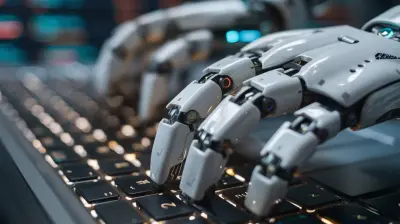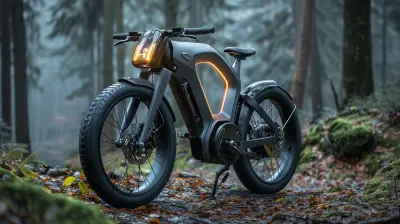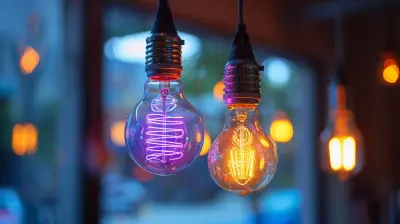Innovations in Battery Materials: Beyond Lithium-Ion
21 June 2025
Let's be real—batteries are the unsung heroes of our daily lives. From the smartphone in your hand to the electric car in your driveway (or the one you're dreaming of), they power just about everything. But the tech world is buzzing with one big question: What's next after lithium-ion batteries?
We've hit some limitations with lithium-ion technology, and while it's given us some incredible advancements, the demand for more powerful, longer-lasting, and environmentally friendly battery solutions has never been higher. So, where do we go from here?
In this article, we’re diving deep into the exciting world of battery innovations and exploring some of the cutting-edge materials that could take us beyond lithium-ion. Buckle up, because things are about to get electrifying (pun intended).
Why Are We Moving Beyond Lithium-Ion?
Before we jump into the future, let’s take a quick look at why we’re not sticking with lithium-ion batteries forever. Don’t get me wrong—lithium-ion batteries have been a game-changer. They’re reliable, relatively lightweight, and have a decent energy density. But, like your favorite pair of sneakers, they’re starting to show their age.Limitations of Lithium-Ion Batteries
1. Limited Energy Density: If you want a battery that can power a smartphone for days or an electric car for thousands of miles on a single charge, lithium-ion just doesn't cut it anymore. The energy density (how much energy you can pack into a given space) has plateaued.2. Safety Concerns: You’ve probably heard those horror stories about lithium-ion batteries catching fire or even exploding. While these incidents are rare, they’re a reminder that lithium-ion isn’t the safest option.
3. Environmental Impact: Mining lithium is a dirty business. It involves extracting lithium from the Earth, which not only depletes natural resources but also has significant environmental impacts, particularly water pollution.
4. Supply Chain Issues: Lithium isn’t exactly abundant everywhere. The increasing demand for electric vehicles (EVs) and renewable energy storage is putting a strain on the global lithium supply chain. Prices are spiking, and we can’t keep relying on a limited resource.
So, what’s the solution? New materials and designs that push the boundaries of what batteries can do. Let's take a look at some of the most promising innovations on the horizon.
1. Solid-State Batteries: The Next Big Thing?
Move over, lithium-ion. There's a new contender in town: solid-state batteries.What Are Solid-State Batteries?
Unlike traditional lithium-ion batteries, which use a liquid or gel electrolyte to move ions between the positive and negative ends, solid-state batteries use a solid electrolyte. That may sound like a small change, but it brings some huge benefits.Why They're Game-Changing
- Higher Energy Density: Solid-state batteries can hold more energy in the same amount of space. That means smaller, lighter batteries that last longer—perfect for everything from smartphones to electric vehicles.- Increased Safety: Because there’s no flammable liquid electrolyte, solid-state batteries are much less likely to catch fire or explode. That’s a win for anyone who's a little paranoid about their devices overheating.
- Longer Lifespan: Solid-state batteries are less prone to wear and tear, meaning they can go through more charge cycles before they start to degrade.
Challenges to Overcome
Solid-state batteries aren’t quite ready for prime time yet. They’re expensive to produce, and there are still some technical challenges to solve, like how to efficiently move ions through the solid electrolyte. But companies like Toyota and Samsung are investing heavily in this technology, so don’t be surprised if you see solid-state batteries powering your next car or smartphone.
2. Sodium-Ion Batteries: A Cheaper, More Sustainable Alternative
While lithium-ion batteries dominate the market, they rely on a finite and increasingly expensive resource: lithium. Enter sodium-ion batteries, which use sodium instead of lithium. Sodium is much more abundant (it’s literally in the ocean), making it a cheaper and more sustainable option.How Do Sodium-Ion Batteries Work?
Sodium-ion batteries work in a similar way to lithium-ion batteries, but with one key difference: they use sodium ions instead of lithium ions to move charge between the anode and cathode. Sodium is larger and heavier than lithium, so sodium-ion batteries typically have a lower energy density. However, they’re much cheaper to produce and more environmentally friendly.Benefits of Sodium-Ion Batteries
- Cost-Effectiveness: Sodium is much cheaper to extract and process than lithium, which could make sodium-ion batteries a more affordable option for mass-market applications.- Environmental Friendliness: Sodium is widely available and doesn’t require the same destructive mining processes as lithium. That makes sodium-ion batteries a greener choice.
- Better Performance in Cold Climates: Sodium-ion batteries perform better in low temperatures compared to lithium-ion, making them ideal for use in colder climates or outdoor applications like grid storage.
Current Limitations
The main drawback of sodium-ion batteries is their lower energy density. They won’t replace lithium-ion in applications that require super high energy storage, like electric cars or high-end electronics, but they could be perfect for grid storage and other less demanding uses.
3. Lithium-Sulfur Batteries: The Next Leap in Energy Density
If you think lithium-ion is the best we can do, think again. Lithium-sulfur (Li-S) batteries promise to offer way more energy density than traditional lithium-ion batteries—up to five times more!How Do Lithium-Sulfur Batteries Work?
Lithium-sulfur batteries use sulfur as the cathode material instead of the more expensive cobalt or nickel found in lithium-ion batteries. When the battery is charged, lithium ions move from the anode to the sulfur cathode, creating energy.Why They Matter
- High Energy Density: Lithium-sulfur batteries have an incredibly high energy density. This could mean electric cars with ranges of over 1,000 miles on a single charge or smartphones that last for weeks without needing a recharge.- Lower Cost: Sulfur is cheap and abundant, meaning lithium-sulfur batteries could be much cheaper to produce than lithium-ion batteries.
- Environmentally Friendly: Sulfur is a byproduct of many industrial processes, so using it in batteries helps recycle an otherwise waste material.
The Drawbacks
The major hurdle for lithium-sulfur batteries is their short lifespan. The sulfur cathode tends to degrade quickly, reducing the number of charge cycles the battery can go through before it needs replacing. However, researchers are working on new designs that could help extend the lifespan of Li-S batteries.4. Graphene Batteries: The Supermaterial Revolution
Graphene has been called a "miracle material", and for good reason. It’s incredibly strong, lightweight, and conductive. So it’s no surprise that researchers are exploring its use in batteries. Graphene batteries have the potential to revolutionize energy storage by offering faster charging times, longer lifespans, and higher energy densities.How Do Graphene Batteries Work?
Graphene batteries are similar to lithium-ion batteries but incorporate graphene into the battery’s structure. Graphene can be used in the anode, cathode, or electrolyte, improving the battery's overall performance.Benefits of Graphene Batteries
- Faster Charging: Graphene batteries can charge significantly faster than traditional lithium-ion batteries. Imagine being able to fully charge your phone in just a few minutes.- Higher Energy Density: Graphene’s lightness and conductivity allow for higher energy storage within the same size battery.
- Longer Lifespan: Graphene batteries degrade much more slowly than traditional batteries, meaning they can last for thousands of charge cycles.
Challenges
Graphene is still expensive to produce at scale, which means graphene batteries aren’t quite ready for mass-market adoption just yet. However, advancements in production techniques could make them more accessible in the near future.5. Bio-Batteries: Power From Nature
This one sounds like something out of a sci-fi movie, but bio-batteries are a real thing. They generate electricity using organic compounds, such as glucose or even bacteria. Think of them as tiny power plants that run on sugar!How Bio-Batteries Work
Bio-batteries use enzymes to break down organic material, such as glucose, and convert it into electricity. Essentially, they mimic the way living organisms generate energy.Advantages of Bio-Batteries
- Sustainability: Bio-batteries offer a renewable, eco-friendly alternative to traditional batteries since they use organic materials.- Biodegradability: Because they’re made from natural compounds, bio-batteries are biodegradable and could significantly reduce electronic waste.
Current Limitations
Bio-batteries are still in the experimental stage and currently don’t offer the same energy density or longevity as lithium-ion or other advanced battery technologies. However, the potential for a truly sustainable battery is exciting.Conclusion: The Future of Batteries is Bright
While lithium-ion batteries are still the gold standard for now, it’s clear that we’re on the brink of a battery revolution. Whether it’s solid-state batteries offering greater safety and energy density, sodium-ion batteries providing a cheaper and greener alternative, or futuristic bio-batteries powering our devices with organic matter, the future of battery technology looks incredibly promising.The innovations we’ve explored here are just the tip of the iceberg. As researchers continue to push the boundaries of what’s possible, we can expect to see even more exciting developments in the years to come. So, stay tuned—your next phone, car, or smartwatch might just be powered by one of these next-gen batteries!
all images in this post were generated using AI tools
Category:
Battery TechnologyAuthor:

Vincent Hubbard
Discussion
rate this article
2 comments
Iris Wolf
The shift towards alternative battery materials, such as solid-state batteries, sodium-ion, and lithium-sulfur technologies, signifies a pivotal movement in energy storage. These innovations promise enhanced safety, improved energy density, and sustainability, addressing lithium's limitations. This evolution is essential for powering the next generation of electric vehicles and renewable energy systems.
November 9, 2025 at 5:28 AM

Vincent Hubbard
Thank you for highlighting the importance of alternative battery technologies! These advancements are indeed crucial for advancing energy storage solutions and driving the future of sustainable transportation and renewable energy.
Jenna Abbott
Exciting developments! It’s inspiring to see how innovations in battery materials could shape a more sustainable energy future.
June 23, 2025 at 4:42 AM

Vincent Hubbard
Thank you! It's thrilling to explore how these innovations can drive sustainability in energy.


